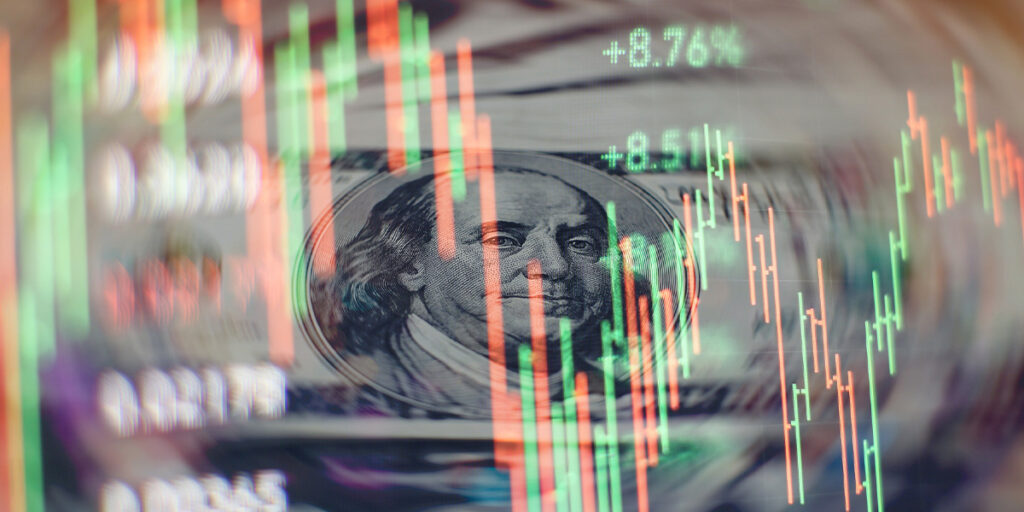For those of you who would prefer to listen:
The balance of risk has changed. That opinion was evident from Fed Chair Powell Friday. In his widely anticipated and widely followed speech he green lighted rate cuts. He indicated increased comfort around taming inflation and believes now the bigger risk is rising unemployment. He appears confident that the risk of recession is going down because the Fed is going to cut interest rates. Some might say the Fed Chair took a victory lap today, celebrating a soft-landing. The Stock Market might agree with that, but looking closer at the internals suggests otherwise. The Bond Market is still very concerned about a recession ahead, as are we.
Stocks have been in rally mode. The bounce off the oversold lows in the wake of the crash in Japan continued this week. It’s basically been a “V” shaped recovery, as the S&P 500 erased nearly all the losses from July’s all-time high. It’s been up 10 out of the last 11 days, following the sharp 8.5% decline. That sell-off created a shock to the system. Fear returned. That corrective price action cleared the decks for another move higher.
While the Stock Market pressed new highs, something different has occurred. The last time the S&P 500 was at similar levels was late June. The Dollar has weakened big time, falling 5% since July, hitting a 7-month low. That’s a big move in the currency world. Its uptrend broke support. Currencies have been super volatile around the Japanese crash a couple weeks ago, but this seems to be an important signal from the United States Dollar which of course remains the world reserve currency. The signal is brace for the slowdown ahead.
This backdrop has created a major tailwind for Gold, which made a new high on Tuesday above $2,560 for the first time. The move was confirmed by a multi-year high for the Gold mining stocks. Gold bars are now worth $1 Million, as the precious metal cleared $2,500 per Troy ounce. A typical gold bar weighs 400 ounces. Gold is one of the few commodities that’s been rallying. It’s largely because it acts more like a currency than commodity. Gold is also considered a safe haven for investors, which is likely the reason it has been capturing large flows of late.
Normally, a weak Dollar is good for commodities as it drives prices higher. Not today. They’re falling. The price of Oil fell to the low $70s, despite the increased conflict in both Ukraine and the Middle East. Other commodities like Copper, Corn, Soybeans and Cocoa keep falling too. This indicates demand is slowing. It adds to the more defensive tone in underlying markets.
Then there’s this: New highs were reached this week for the Equal Weighted S&P. Tech dominance has been a theme all year for the Stock Market, with the Top 7 stocks accounting for most, if not all the gains through June. Leadership was extremely narrow. That’s changed.
Bloomberg created an index of the 500 biggest US stocks excluding the so-called “Magnificent 7”. In other words, it’s the “S&P Other 493” stock index. It also hit an all-time record high this week. The thing is, the Tech Titans are nowhere near their all-time highs reached in July. Make no mistake, it’s a really good thing that leadership has broadened out with a much wider participation. We were looking for that. The important point is what’s leading right now. The snapback rally in August has been led by Utilities, Health Care and Consumer Staples. These are really defensive areas, which normally do well when growth slows. Despite the broadening out of leadership, the percentage of issues making 20-day highs is a meager 18%. That’s definitely not a sign of acceleration.
The Bond Market has been telling the slow growth story. The 10-Year Treasury went below 3.8%, the lowest levels of the year. It hasn’t been this low since Silicon Valley Bank failed in the Spring of last year. 2-Year yields have been collapsing. That’s the Market saying the Fed is too restrictive. The Bond Market is forcing its hand. Cuts are clearly coming. But not for another month. Will it be too late? Will they be enough? The Economy slowing and lower yields are generally reflective of potential recession ahead.
Here’s another kicker: Job growth was significantly weaker than initially estimated this year. Over 800K jobs that were deemed to have been created were erased. This was the biggest downward adjustment since the Financial Crisis. Data revisions are quite common. Rarely does it come to that degree, even with the large standard deviation typically assigned to non-farm payroll figures. I just had to look into this further.
The Bureau of Labor Statistics (BLS) usually surveys on average 125K businesses each month. The department then extrapolates the data from those surveys to get an estimate of how many jobs were created throughout America’s Economy. The quarterly re-estimation process looks back at 60 Million business records, many of which were not available at the time of the initial monthly payroll releases. The records can include unemployment benefits, seasonal hiring for the holidays, and unavoidable lags, such as delayed payroll data, which can give a better picture of overall economic activity. It’s clearly not a perfect science. They missed by 800K.
The Market has always had issues with government data. But it’s what we got. Initial estimates are generally in line with trends. But the accuracy of the BLS data has been called into question more recently, with requests to revise the birth-death models of corporations or other influential factors including undocumented migrants. That’s clearly been an issue in 2024.
What it means: Simply put, watching the unemployment rate is more important than the actual numbers. It’s the trend that matters most. The Market looks for uptrends, downtrends, and of course most importantly, the changing of trends. Things look different going forward given the rising unemployment rate. That’s what seems to have cemented a Fed rate cut in September. The Stock Market clearly is excited by this development.
The outlook for economic growth in the second half of 2024 has already been clipped and the July Fed meeting minutes circulated this week noted the majority believe that easing too late could further weaken the Economy. The Street takeaway is the revised job report didn’t do much to change the view that the Labor Market is slowing but not fast enough that would push the Fed to a more aggressive ½-point cut in September. It’s assigning just a 36.4% probability of that now versus 76% in the wake of the Japanese crash. The Market thinks at least a ¼-point cut is guaranteed.
Chair Powell has always stated Fed decisions are based on data. He said it again Friday in Jackson Hole. More data is coming. Before the September meeting will be the August job report and a slew of other economic updates. He is clearly comfortable now with the plan to reverse course and cut rates. As a reminder, the Fed hiked interest rates 11 times starting in March of 2022 to a total of 5.25%. It also cut $2 Trillion from its balance sheet. That came mostly in the form of Treasury bond maturities which were bought during Covid taking its balance sheet up to a record $9 Trillion. Yes, $9 Trillion. That was just unthinkable, pre-Covid.
We can’t get past the fact that the Fed is notoriously slow. As price pressures spiraled out of control in 2021, the Fed Chair doubled down on that infamous “transitory” call before making a serious U-turn that led to an aggressive tightening cycle in 2022. Exactly 2 years ago at this very summit in Wyoming, the Fed Chair warned of pain ahead with more hikes to come. If you remember, 2022 definitely brought pain to the Market. That pain was soothed quite convincingly in 2023 and much of 2024. After a historic rally to all-time highs, the Fed is very capable of inflicting pain, even if it’s unintended. First cuts aren’t always Bullish. Keep in mind, cuts come when growth is sluggish. The average return for the ensuing 3 months after the 1st rate cut is close to down 5%.
We love seeing green on the screen and sure do enjoy the gains. But our focus is always what’s next. That’s why when we see signals and trend changes, we begin to actively start protecting those gains. That’s where we are at this stage.
Have a nice weekend. We’ll be back, dark and early on Monday.
Mike







